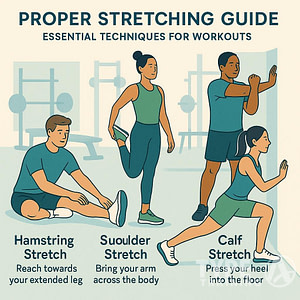When it comes to selecting corporate fitness program components, it’s important to understand the different options available and how they can benefit your employees. Corporate fitness programs can include a variety of components, such as group fitness classes, nutrition and wellness education, mindfulness and stress reduction programs, and more. By offering a comprehensive wellness program, you can support your employees in leading healthier lives, improve their productivity and job satisfaction, and reduce healthcare costs for your organization.
Evaluating fitness program vendors is an important step in designing a corporate fitness plan that meets the needs of your employees and your organization. Look for vendors that offer a holistic approach to wellness and integrate their programming into your organization’s structure. Leadership support and investment in strategy and implementation are also key factors to consider. Additionally, programming should be easily accessible for employees and include awareness and engagement activities to encourage participation.
Promoting an active company culture is also essential to the success of your corporate fitness program. Encourage employees to participate in fitness challenges, provide incentives for meeting wellness goals, and create a supportive environment where employees feel comfortable sharing their progress and successes. By prioritizing employee wellness, you can create a healthier, happier, and more productive workforce.
Key Takeaways
- Corporate fitness programs can include a variety of components, such as group fitness classes, nutrition and wellness education, and mindfulness and stress reduction programs, among others.
- When selecting a fitness program vendor, look for a holistic approach to wellness, leadership support, and easily accessible programming with awareness and engagement activities.
- Promoting an active company culture through fitness challenges, incentives, and a supportive environment can help improve employee wellness and productivity.
Understanding Corporate Fitness Programs
Popular posts:
Corporate fitness programs are initiatives implemented by organizations to encourage and support employee physical activity and overall well-being. These programs aim to improve employees’ physical and mental health, increase productivity, and reduce healthcare costs. In this section, we will discuss the importance of corporate fitness programs and the components of a comprehensive wellness program.
Importance of Corporate Fitness Programs
A sedentary lifestyle can lead to various health problems, including obesity, heart disease, and diabetes. Corporate fitness programs aim to encourage employees to adopt an active lifestyle by providing them with resources and opportunities to engage in physical activity. These programs not only improve employees’ physical health but also their mental health, reducing stress levels and improving overall well-being.
In addition to improving employee health, corporate fitness programs can also benefit the organization. By reducing healthcare costs and increasing productivity, these programs can contribute to the organization’s bottom line. Furthermore, offering wellness programs can improve employee retention rates and attract top talent.
Components of a Comprehensive Wellness Program
A comprehensive wellness program should include various components that address different aspects of employee well-being. These components may include:
- Fitness Program: A fitness program should provide employees with opportunities to engage in physical activity, such as gym memberships, exercise classes, and sports teams. Offering a variety of options can help employees find an activity they enjoy and are more likely to stick with.
- Health Education: Health education programs should provide employees with information on healthy lifestyle choices, such as nutrition, stress management, and sleep hygiene. These programs can help employees make informed decisions about their health and well-being.
- Mental Health Support: Mental health support programs should provide employees with access to resources and support for managing stress, anxiety, and other mental health issues. These programs can help reduce absenteeism and presenteeism due to mental health concerns.
- Yoga and Meditation: Yoga and meditation can be effective tools for managing stress and improving overall well-being. Offering classes or resources for employees to practice these activities can be a valuable component of a comprehensive wellness program.
- Incentives: Incentives can motivate employees to participate in wellness programs and engage in healthy behaviors. Incentives may include rewards for meeting fitness goals, completing health assessments, or participating in wellness challenges.
A table is an effective way to summarize the components of a comprehensive wellness program:
| Component | Description |
|---|---|
| Fitness Program | Provides opportunities for physical activity |
| Health Education | Provides information on healthy lifestyle choices |
| Mental Health Support | Provides resources for managing mental health |
| Yoga and Meditation | Provides classes or resources for practicing yoga and meditation |
| Incentives | Rewards for participating in wellness programs |
Evaluating Fitness Program Vendors
When it comes to selecting the right corporate fitness program components, choosing the right vendor is crucial. To evaluate fitness program vendors, you need to conduct thorough research and apply specific selection criteria.
Researching Potential Vendors
Before selecting a fitness program vendor, you need to research potential vendors. You can start by looking up fitness companies online and checking their websites for information about their programs. You can also ask for recommendations from colleagues or other companies that have implemented successful fitness programs.
Once you have a list of potential vendors, you can evaluate them based on their experience, reputation, and track record. For example, Type A Training of NYC is a well-known fitness company that offers customized fitness programs for corporate clients. Exos is another popular vendor that provides comprehensive wellness solutions to companies of all sizes.
Vendor Selection Criteria
When evaluating fitness program vendors, you need to consider several selection criteria. Here are some of the most important factors to consider:
- Program customization: Does the vendor offer customized fitness programs that meet your company’s specific needs and goals?
- Program variety: Does the vendor offer a wide variety of fitness options, including yoga and meditation, to keep employees engaged and motivated?
- Program quality: Does the vendor have certified and experienced fitness instructors who can deliver high-quality fitness programs?
- Program tracking: Does the vendor provide tools and resources to track employee participation and progress in the fitness program?
- Program cost: Is the vendor’s pricing competitive and transparent, with no hidden fees or charges?
By evaluating fitness program vendors based on these criteria, you can select a vendor that offers the best value for your company’s fitness program needs.
Designing a Corporate Fitness Plan
When designing a corporate fitness plan, there are several factors to consider. By setting clear fitness goals, incorporating various fitness activities, utilizing on-site fitness facilities and equipment, and virtual fitness programs and equipment, you can create a comprehensive and effective plan that meets the needs of your employees.
Setting Fitness Goals
The first step in designing a corporate fitness plan is to set clear fitness goals. These goals should be specific, measurable, and achievable. For example, you may want to improve employee health by reducing stress levels, increasing cardiovascular fitness, or building strength and flexibility. By setting goals that are tailored to the needs of your employees, you can ensure that your fitness plan is effective and sustainable.
Incorporating Various Fitness Activities
To keep your employees engaged and motivated, it’s important to incorporate a variety of fitness activities into your plan. This may include yoga, cardio, strength training, and flexibility training. By offering a range of activities, you can cater to the different fitness levels and interests of your employees. Additionally, offering group fitness classes can help build a sense of community and encourage teamwork.
Utilizing On-Site Fitness Facilities and Equipment
If your workplace has on-site fitness facilities, such as a gym or fitness center, it’s important to utilize these resources in your fitness plan. By providing employees with access to these facilities, you can make it easier for them to exercise before or after work, during lunch breaks, or at other convenient times. Additionally, providing fitness equipment such as treadmills, ellipticals, and weight machines can help employees achieve their fitness goals.
Virtual Fitness Programs and Equipment
In addition to on-site facilities and equipment, virtual fitness programs and equipment can also be effective components of a corporate fitness plan. Virtual fitness programs, such as online yoga classes or guided meditation sessions, can provide employees with convenient and accessible ways to exercise and reduce stress. Wearable fitness trackers, such as Fitbit or Apple Watch, can also help employees track their progress and stay motivated.
To summarize, designing a comprehensive corporate fitness plan involves setting clear fitness goals, incorporating a variety of fitness activities, utilizing on-site facilities and equipment, and virtual fitness programs and equipment. By taking these factors into consideration, you can create a plan that meets the needs of your employees and helps them achieve their fitness goals.
Sources:
| Fitness Activity | Benefits |
|---|---|
| Yoga | Improves flexibility, reduces stress, and promotes relaxation |
| Cardio | Increases cardiovascular fitness, improves energy levels, and reduces the risk of chronic diseases |
| Strength Training | Builds muscle mass, improves bone density, and boosts metabolism |
| Flexibility Training | Improves range of motion, reduces the risk of injury, and promotes relaxation |
Group Fitness Classes for Corporate Employees to Boost Health and Wellness
Group fitness classes are a great way to improve health and wellness in corporate environments. They can help employees stay motivated while also building camaraderie and teamwork. Here are two popular group fitness classes that can help boost health and wellness in corporate environments.
Yoga Classes
Yoga is a low-impact exercise that can help reduce stress and promote relaxation. It can also improve flexibility, balance, and strength. Yoga classes are a great way to help employees reduce stress and improve their overall well-being.
According to a study published in the Journal of Occupational Health Psychology, yoga can help reduce stress and improve overall well-being in employees. The study found that employees who participated in a yoga program reported reduced stress levels, improved job satisfaction, and improved overall health.
Weight Management Strategies
Weight management strategies are another important component of corporate fitness programs. Excess weight can lead to a variety of health problems, including heart disease, diabetes, and high
One effective weight management strategy is to encourage employees to engage in regular exercise. Exercise can help burn calories and build muscle, which can help improve overall health and well-being. Another effective strategy is to provide employees with healthy eating options, such as fresh fruits and vegetables, lean proteins, and whole grains.
According to a study published in the Journal of Occupational and Environmental Medicine, weight management programs can help employees lose weight and improve their overall health. The study found that employees who participated in a weight management program lost an average of 5.5 pounds and improved their overall health and well-being.
| Benefits of Group Fitness Classes for Corporate Employees |
|---|
| Improved overall health and well-being |
| Reduced stress levels |
| Improved job satisfaction |
| Enhanced teamwork and camaraderie |
| Reduced risk of developing health problems |
| Increased motivation to exercise regularly |
In conclusion, group fitness classes are an effective way to promote health and wellness in corporate environments. Yoga classes and weight management strategies are two popular components of corporate fitness programs that can help employees reduce stress, maintain a healthy weight, and improve their overall well-being. By implementing these strategies, companies can help their employees lead healthier, happier lives.
Nutrition and Wellness
When it comes to selecting components for your corporate fitness program, nutrition and wellness should be a top priority. Promoting healthy eating habits and weight management strategies can have a significant impact on the overall health and well-being of your employees.
Promoting Healthy Eating Habits
Encouraging healthy eating habits in the workplace can be achieved through a variety of methods. Providing healthy food options in the cafeteria or vending machines, offering nutrition education classes or seminars, and promoting healthy eating habits through company-wide challenges are just a few examples.
One effective way to promote healthy eating habits is to provide healthy snacks in the workplace. This can help prevent employees from reaching for unhealthy options when they get hungry throughout the day. Some healthy snack options include:
- Fresh fruit
- Nuts and seeds
- Yogurt
- Cut-up vegetables with hummus or other healthy dips
Another way to promote healthy eating habits is to encourage employees to pack their own healthy lunches. Providing resources and tips on healthy meal prep and planning can help employees make healthier choices and stay on track with their nutrition goals.
Weight Management Strategies
Weight management is another important aspect of nutrition and wellness. Being overweight or obese can increase the risk of many health problems, including heart disease, diabetes, and certain types of cancer.
One effective weight management strategy is to encourage physical activity. Providing on-site fitness classes or gym access can help employees stay active and maintain a healthy weight. Additionally, promoting active transportation options like walking or biking to work can also be effective.
Another weight management strategy is to provide resources and support for healthy weight loss. This can include nutrition education classes, weight loss challenges, and access to registered dietitians or other health professionals.
| Food Group | Daily Serving Recommendation |
|---|---|
| Fruits | 2 cups |
| Vegetables | 2.5 cups |
| Grains | 6 ounces |
| Protein | 5.5 ounces |
| Dairy | 3 cups |
Sources:
- CDC – Healthy Eating for a Healthy Weight
- Mayo Clinic – Weight loss: 6 strategies for success
Incorporating nutrition and wellness components into your corporate fitness program can help improve the overall health and well-being of your employees. By promoting healthy eating habits and weight management strategies, you can help your employees lead healthier, happier lives.
Mindfulness and Stress Reduction Programs
Incorporating mindfulness and stress reduction programs into your corporate fitness program can have significant benefits for your employees. These programs can help reduce stress, improve mental well-being, mood, cognitive function, and memory.
Benefits of Meditation
Meditation is a powerful tool for managing stress and improving overall mental health. Research shows that regular meditation can reduce symptoms of anxiety and depression and improve cognitive function.
One study found that a mindfulness-based stress reduction program (MBSR) significantly reduced stress and burnout among healthcare workers. Another study showed that mindfulness meditation can improve sleep quality and reduce symptoms of insomnia.
Importance of Rest and Sleep
Rest and sleep are essential for overall health and well-being. Lack of sleep can lead to increased stress, mood disturbances, and cognitive impairment. Incorporating mindfulness and relaxation techniques into your corporate fitness program can help employees improve their sleep quality and reduce stress levels.
One effective technique is yoga, which combines physical activity with mindfulness and relaxation. A study found that practicing yoga regularly can improve sleep quality and reduce symptoms of insomnia.
Another technique is progressive muscle relaxation, which involves tensing and relaxing different muscle groups to promote relaxation. This technique has been shown to reduce stress and improve sleep quality.
When designing your corporate fitness program, consider incorporating mindfulness and stress reduction programs such as meditation, yoga, and progressive muscle relaxation. These programs can help your employees reduce stress, improve mental well-being, and promote better sleep quality.
| Type of Program | Benefits |
|---|---|
| Meditation | Reduces stress, improves cognitive function, and mood |
| Yoga | Improves sleep quality, reduces symptoms of insomnia |
| Progressive Muscle Relaxation | Reduces stress, improves sleep quality |
Sources:
- Mindfulness-Based Programs in the Workplace: a Meta-Analysis of Randomized Controlled Trials
- Reduce Stress Through Mindfulness – Whole Health – Veterans Affairs
Legal and Safety Considerations
When selecting components for your corporate fitness program, it is important to consider the legal and safety implications. Failing to do so can result in costly lawsuits and negative publicity for your company. This section will cover two important areas to consider: liability waivers and addressing health risks.
Understanding Liability Waivers
A liability waiver is a legal document that releases a company from liability for injuries or damages that may occur during a fitness program. It is important to have participants sign a waiver before beginning any fitness activities to protect your company from potential lawsuits.
When creating a liability waiver, it is important to be clear and specific about the risks involved in the fitness program. The waiver should also be written in plain language that is easy for participants to understand. It is recommended to have a lawyer review the waiver to ensure it is legally binding and covers all necessary areas.
Addressing Health Risks
When designing a corporate fitness program, it is important to consider the health risks that participants may face. Some participants may have pre-existing medical conditions that could be aggravated by certain exercises. It is important to have participants fill out a health questionnaire before beginning any fitness activities to identify any potential risks.
It is also important to have a trained professional, such as a certified personal trainer, lead the fitness activities. They can ensure that participants are performing exercises correctly and safely, and can modify exercises as needed to accommodate individual needs.
Additionally, it is important to consider the impact of lifestyle factors on health. Smoking and high cholesterol, for example, can increase the risk of heart disease and other health problems. Incorporating education on healthy lifestyle choices into the fitness program can help participants make positive changes and reduce their risk of health problems.
Sources:
To convey the information clearly and concisely, a bullet point table is the best type of table to use in this section.
- Liability Waivers
- Clear and specific about risks
- Written in plain language
- Reviewed by a lawyer
- Addressing Health Risks
- Health questionnaire
- Trained professional to lead activities
- Education on healthy lifestyle choices
Promoting an Active Company Culture
Promoting an active company culture is an essential component of any corporate fitness program. Encouraging employees to stay active and healthy can have a positive impact on their well-being, productivity, and overall job satisfaction. Here are some ways to promote an active company culture:
Set Goals
Setting goals is a great way to motivate employees to participate in the fitness program. Goals can be individual or team-based and can be related to physical activity levels, weight loss, or other health metrics. By setting achievable goals, employees are more likely to stay engaged and motivated throughout the program.
Step Challenges
Step challenges are a fun and engaging way to promote physical activity in the workplace. Employees can compete against each other or work together as a team to reach a common goal. Step challenges can be tracked using fitness trackers or mobile apps, and progress can be displayed on a leaderboard to encourage friendly competition.
Yoga and Meditation
Yoga and meditation are great ways to promote mental and physical well-being in the workplace. Offering yoga and meditation classes as part of the corporate fitness program can help reduce stress, improve focus, and increase overall job satisfaction. These activities can be done in a group setting or individually, and can be tailored to all fitness levels.
Sources
According to Inkin, promoting an active company culture is an important component of any corporate fitness program. They suggest setting goals, step challenges, and offering yoga and meditation classes as ways to promote physical and mental well-being in the workplace.
Another source, Vantage Fit, also recommends setting goals and step challenges as ways to promote an active company culture. They suggest that step challenges can be a fun and engaging way to get employees moving and can help increase overall job satisfaction.
Frequently Asked Questions
What are some key components of an effective corporate fitness program?
An effective corporate fitness program should include a variety of components that promote physical activity, healthy eating, and stress relief. Some key components include fitness challenges, group exercise classes, healthy food options, mental health resources, and incentives for participation.
How can a wellness fitness program benefit a company and its employees?
A wellness fitness program can benefit both a company and its employees in many ways. For employees, it can improve physical health, reduce stress, and increase job satisfaction. For companies, it can reduce healthcare costs, improve productivity, and enhance employee retention.
What are some best practices for selecting fitness program components for a corporate wellness program?
When selecting fitness program components for a corporate wellness program, it is important to consider the needs and interests of employees. It can be helpful to survey employees to gather feedback and ideas. Additionally, it is important to choose components that are accessible, affordable, and sustainable.
What are some common mistakes to avoid when creating a corporate fitness program?
One common mistake when creating a corporate fitness program is focusing too heavily on physical fitness and neglecting mental health. It is also important to avoid making participation mandatory or creating a competitive environment that may discourage some employees from participating. Lastly, it is important to avoid selecting components that are too expensive or difficult to sustain over time.
How can a corporate wellness program improve employee morale and productivity?
A corporate wellness program can improve employee morale and productivity by promoting physical and mental health, reducing stress, and creating a sense of community among employees. Additionally, when employees feel that their employer cares about their well-being, they may be more motivated to perform well at work.
What are some strategies for measuring the success of a corporate fitness program?
Measuring the success of a corporate fitness program can be done in a variety of ways. Some strategies include tracking participation rates, conducting employee surveys, tracking healthcare costs, and monitoring changes in employee health outcomes such as weight loss or reduced stress levels.













